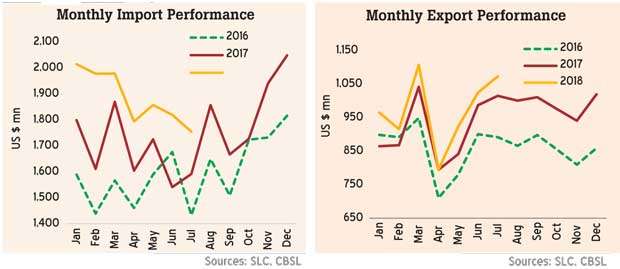Reply To:
Name - Reply Comment

Sri Lanka’s merchandize trade deficit continued to expand as the fuel bill rose significantly amid increasing world oil prices and the import of personal vehicles, which more than doubled in July.
According to the external performance data released by the Central Bank yesterday for the month of July, Sri Lanka’s imports rose more than 10 percent to US $ 1,754 million year-on-year (YoY), on the back of a 28 percent increase in the fuel import bill and over 120 percent increase in personal motor vehicles. Sri Lanka spent US $ 276.6 million on fuel in July and for the first seven months, the total bill was US $ 2.4 billion, up 29 percent YoY.
At Brent, the international benchmark for crude oil is hovering around US $ 85 a barrel, up little under 20 percent so far during the year and analysts forecast prices reaching US $ 100 in anticipation of the impending United States’ sanctions on Iran, effective
in November.
Meanwhile, the US $ 90 billion island economy spent slightly below a billion dollars on personal vehicle imports during the first seven months alone, before the policymakers took a raft of measures to curtail the unprecedented number of vehicles coming into the country.
In July alone, the country spent US $ 137 million on importation of vehicles. The Finance and Mass Media Ministry jacked up excise duties on motor cars less than 1000 CC in August. In September, the Central Bank took measures to increase the margin requirement on opening letters of credit to import vehicles up to 100 percent of the value of the vehicle, which was further increased to 200 percent, as the policymakers are battling a weakening currency amid the rising imports.
Overall, while the consumer goods imports rose by 16.4 percent YoY in July, the non-food consumer goods, which capture personal vehicles, medicines and clothing, home appliances and furniture, rose by 37.5 percent to US $ 277 million.
However, the food and beverage imports declined by 15.5 percent to US $ 112.5 million.
Meanwhile, despite the weakening rupee, the exports languished as the earnings for July grew by less than 6.0 percent YoY to a little under US $ 1.1 billion, as earnings from apparel lost steam, while the major agricultural exports fared poorly.
Textiles and garments exports declined 0.2 percent YoY to US $ 466 million in July, amid tepid demand from the United States and some other non-traditional buyers such as Canada, the UAE and Australia.
Textiles and garments, which have the title of the largest merchandize export commodity, earned little under US $ 3.0 billion, up 4.7 percent YoY during the first seven months of the year.
Meanwhile, earnings from tea exports declined by 12.4 percent YoY to US $ 125 million in July, due to the declines in both price and volumes.
For the first seven months, earnings from tea were US $ 854 million, down 2.0 percent YoY.
“Earnings from coconut declined owing to the reduction in all kernel categories as a result of lower export volumes despite the higher prices reported for these products.
Under industrial exports, earnings from export of petroleum products increased significantly due to the higher export prices of bunker and aviation fuel despite the reduction in volumes. Export earnings from transport equipment increased considerably during the month, owing to the export of a cruise ship to Singapore,” the Central Bank said.
Overall, during the first seven months of this year, Sri Lanka imported goods worth of US $ 13.2 billion, up 12.4 percent YoY and exported goods valued at US $ 6.8 billion, up 6.1 percent YoY, creating a wider trade deficit of US $ 6.4 billion. During the same period, last year, the trade deficit was US $ 5.3 billion.